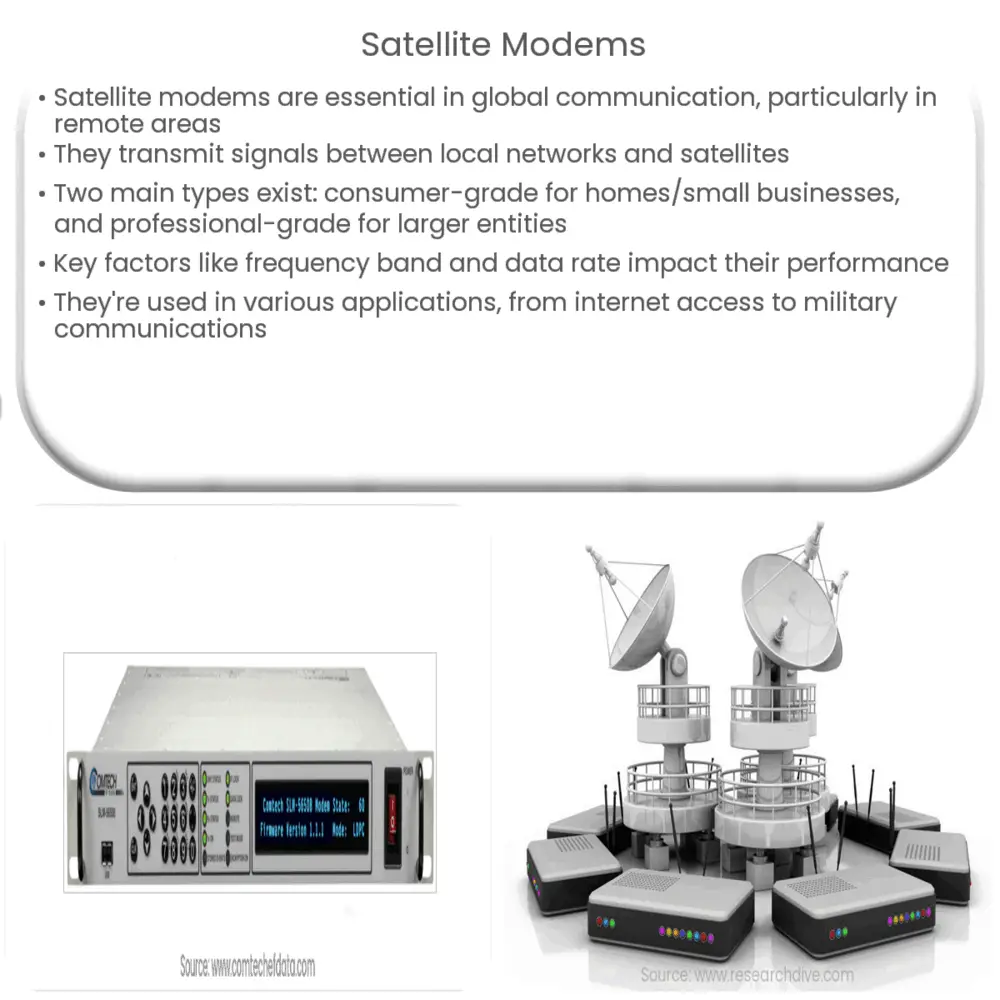Explore the world of satellite modems, their functions, types, key features, and applications. Understand their crucial role in global connectivity.

Satellite Modems: Understanding their Function and Importance
Satellite modems, also known as satmodems, play a crucial role in global communication infrastructure. They are the unsung heroes that facilitate satellite communication, enabling connections across vast distances and even to remote areas where conventional internet access might be impossible.
Like other types of modems, satellite modems work by modulating and demodulating signals, essentially converting digital signals to analog for transmission and vice versa for receiving. But unlike regular modems that communicate through telephone or cable lines, satmodems communicate with satellites orbiting Earth.
Working Principle of Satellite Modems
The basic principle of operation for a satellite modem involves a two-way communication system. This process begins with the user’s request data, which is transmitted from a satellite dish installed at the user’s location to a specific satellite in geostationary orbit. The satellite then sends the request to a hub station on the ground, which connects to the internet to retrieve the requested data. The data is then sent back to the user following the same path in reverse.
- Modulation: The process of converting digital data into a format suitable for transmission. This involves changing certain properties of the carrier wave, such as its amplitude, frequency, or phase, in accordance with the data being sent.
- Demodulation: This is essentially the reverse of modulation. The received signal is converted back into its original digital format.
In this way, satmodems act as bridges between local networks (such as a home network) and the wider internet.
Types of Satellite Modems
There are two main types of satellite modems: consumer-grade modems and professional-grade modems.
- Consumer-grade Satellite Modems: These are the types of modems typically used in homes or small businesses. They are generally more affordable and easier to set up and use, but may not offer the same level of performance or reliability as professional-grade modems.
- Professional-grade Satellite Modems: These are more robust, providing a higher level of performance and stability. They are used in large corporations, government entities, and telecommunication companies where reliability and speed are crucial.
Regardless of the type, these devices provide a vital link to the internet for people in remote or hard-to-reach areas, helping to bridge the digital divide and foster global connectivity.
Key Features and Performance Factors
Satellite modems have a range of features that can affect their performance, such as the frequency band they operate on, modulation and coding schemes, data rate, and more. These features allow them to adapt to the specific requirements of various applications and environments.
- Frequency Band: Different modems operate on different frequency bands, such as C-band, Ku-band, or Ka-band, each with its own strengths and weaknesses.
- Modulation and Coding Schemes: Modems can use various modulation and coding schemes to optimize data transfer, depending on the conditions of the satellite link.
- Data Rate: The data rate can vary depending on the application, with some modems capable of supporting very high data rates.
Applications of Satellite Modems
Satellite modems are used in a variety of applications, ranging from internet access for homes and businesses, to backhaul for cellular networks, to military communications.
- Internet Access: For areas where terrestrial internet access is not available or reliable, satellite internet can be a viable alternative.
- Cellular Backhaul: Satellite modems can provide connectivity for remote cellular towers, enabling mobile coverage in areas that might otherwise be unreachable.
- Military Communications: Due to their ability to provide connectivity in remote or difficult terrains, satellite modems are often used in military operations.
Conclusion
In conclusion, satellite modems are a vital piece of technology that enable internet access in remote and hard-to-reach locations. They modulate and demodulate signals for transmission to and from satellites, bridging the gap between local networks and the wider internet. With a variety of types and performance factors, these devices are adaptable to a range of different applications and environments, from consumer internet access to cellular backhaul and military communications. Despite the challenges posed by latency and weather sensitivity, satellite modems remain a critical technology in our global communications infrastructure, fostering connectivity and information exchange across our increasingly digital world.

